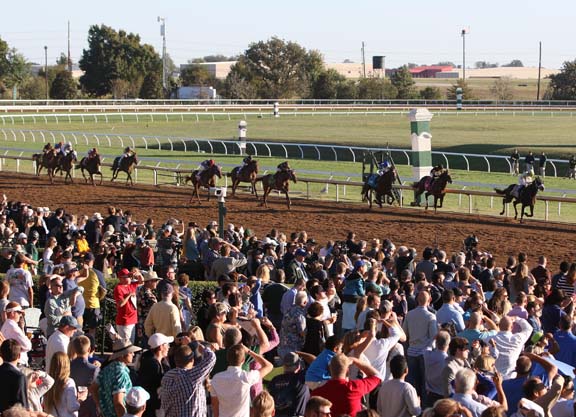Keeneland will require jockeys competing in the 2017 Fall Meet, which begins Friday, to complete a baseline concussion assessment prior to being allowed to ride, the track announced Thursday. The Lexington oval is among the first racetracks in the U.S. to establish concussion management and return to participation protocol.
“Keeneland is proud of this concussion protocol and the collaborative effort that created it,” Keeneland Vice President of Racing and Sales Bob Elliston said. “This is another critical step in maintaining the safest possible racing environment for our jockeys.”
The move is part of a pilot project between the Jockeys' Guild and the University of Kentucky, funded by a number of Thoroughbred industry organizations. Initially conceived by Keeneland Medical Director Dr. Barry Schumer and now overseen by Carl Mattacola, PhD and Associate Dean, UK College of Health Sciences, the protocol was developed over several years, and guidelines were assessed and approved by the Jockeys' Guild Board of Directors.
“Implementation of a mandatory baseline testing protocol and the subsequent guidelines to determine return to participation after a suspected head injury improves medical care and thus prevents more serious injury,” Mattacola said. “This protocol, similar to the sports medicine model currently instituted at Pimlico, provides a standard of care and serves as a model for other racetracks to institute. We are grateful to the industry sponsors who helped make this a reality.”
The protocol follows guidelines established by the consensus statement at the Fifth International Conference on Concussion in Sport in Berlin in October 2016. It provides a systematic methodology so that a return to participation decision can be made using an evidence-based approach, similar to the ones used by the NFL, NBA, NASCAR and NCAA.
“It is our belief that head injuries are one of the most pressing issues that jockeys and their families face today,” Terry Meyocks, National Manager of the Jockeys' Guild, said. “We greatly appreciate the University of Kentucky for conducting this pilot project, as well as the support we received from all of the other racetracks in Kentucky and industry organizations. The Board strongly believes that it is imperative that on-track medical personnel are trained in concussion management and hopes that these guidelines will be implemented at tracks throughout the country.”
Under the guidelines, all jockeys riding at Keeneland must maintain an active account in the Jockey Health Information System (JHIS). If a jockey incurs a fall and/or suspected concussion, he or she will undergo a standardized concussion management assessment, the SCAT-5 (Sport Concussion Assessment Tool), to evaluate physical feeling, symptoms, memory and cognitive function prior to being cleared to ride again.
Post-injury assessments will be uploaded to the JHIS for comparison and assessment after an incident. The JHIS, implemented in 2008, is a national database of jockeys' updated medical histories, so in the event of an injury, the records are immediately accessible to emergency personnel at racetracks throughout the country.
Not a subscriber? Click here to sign up for the daily PDF or alerts.






